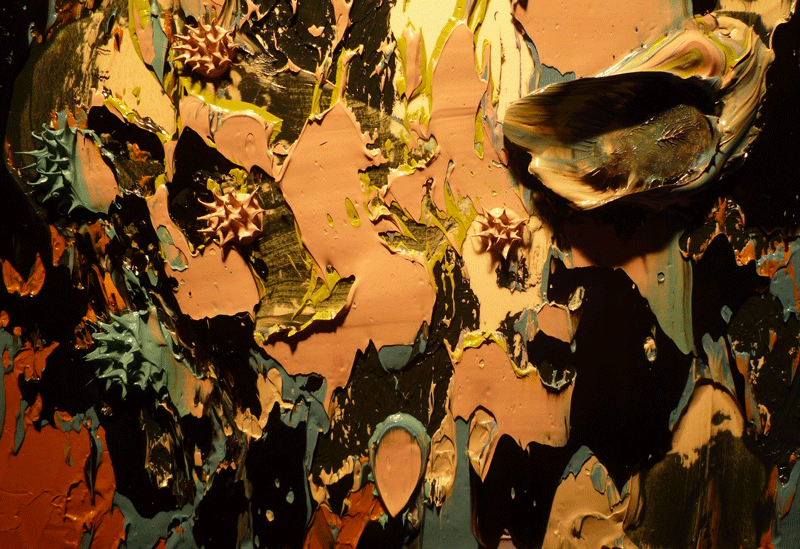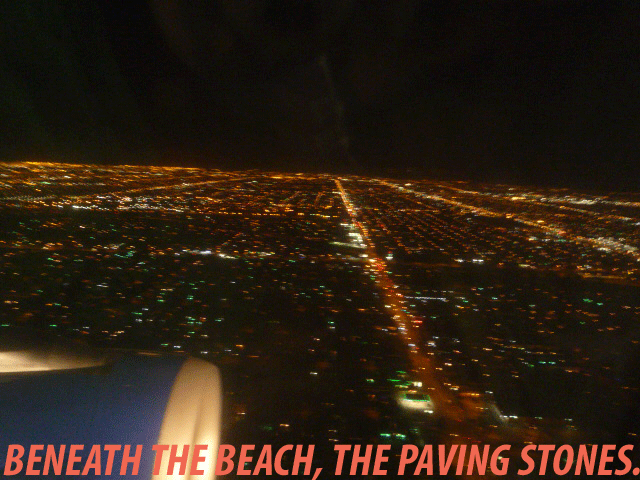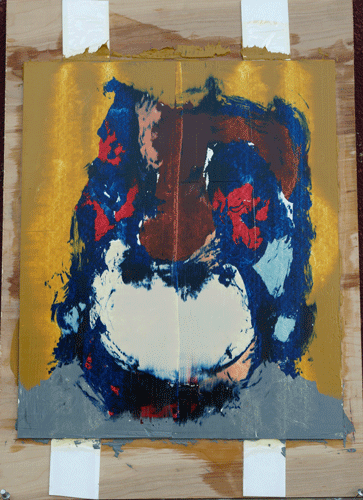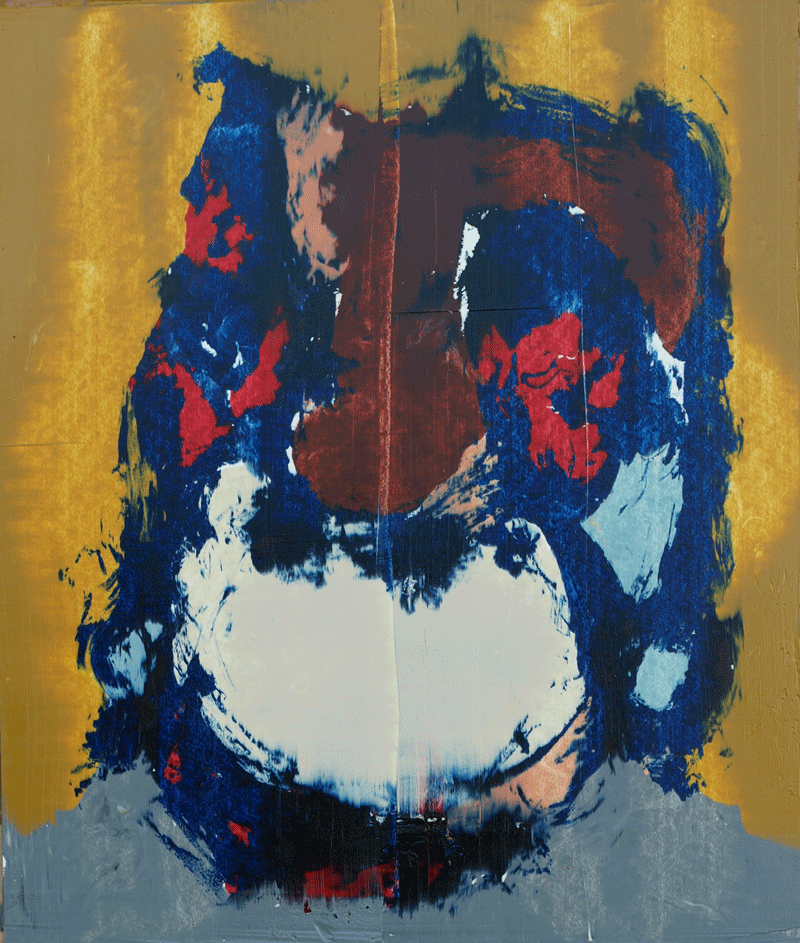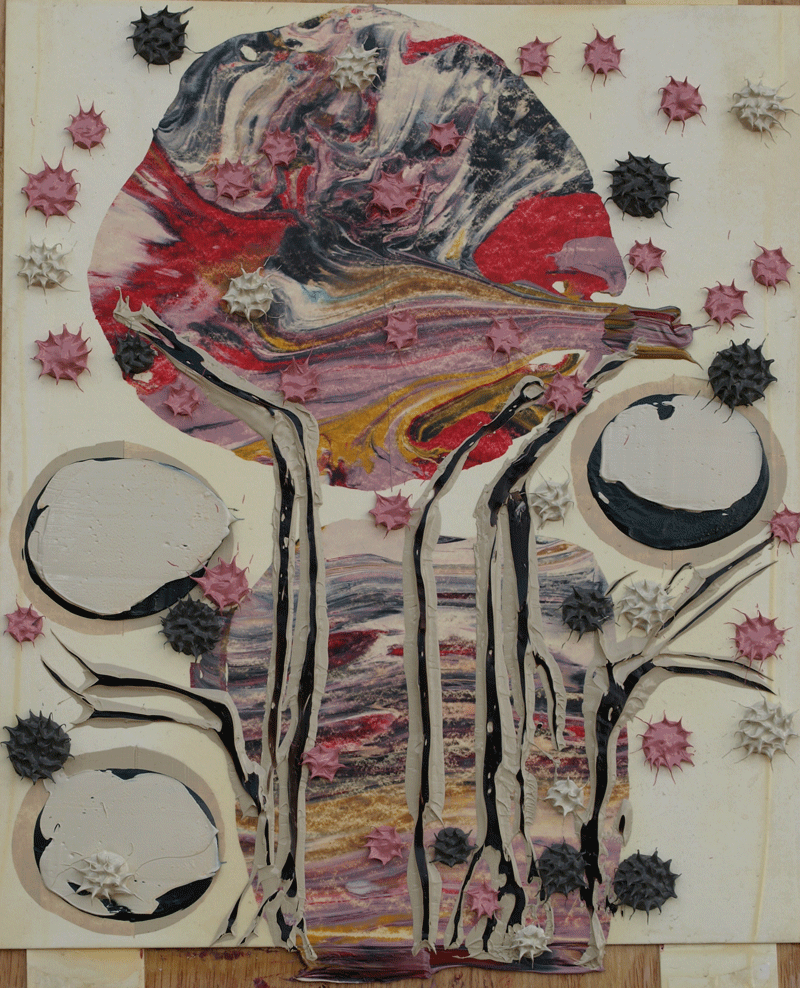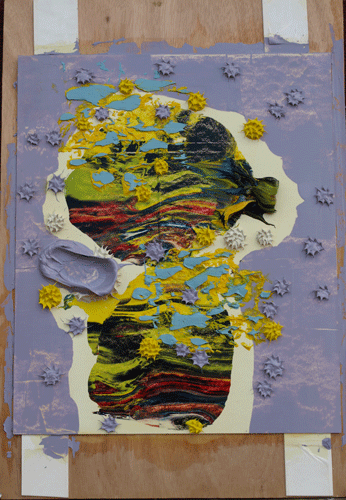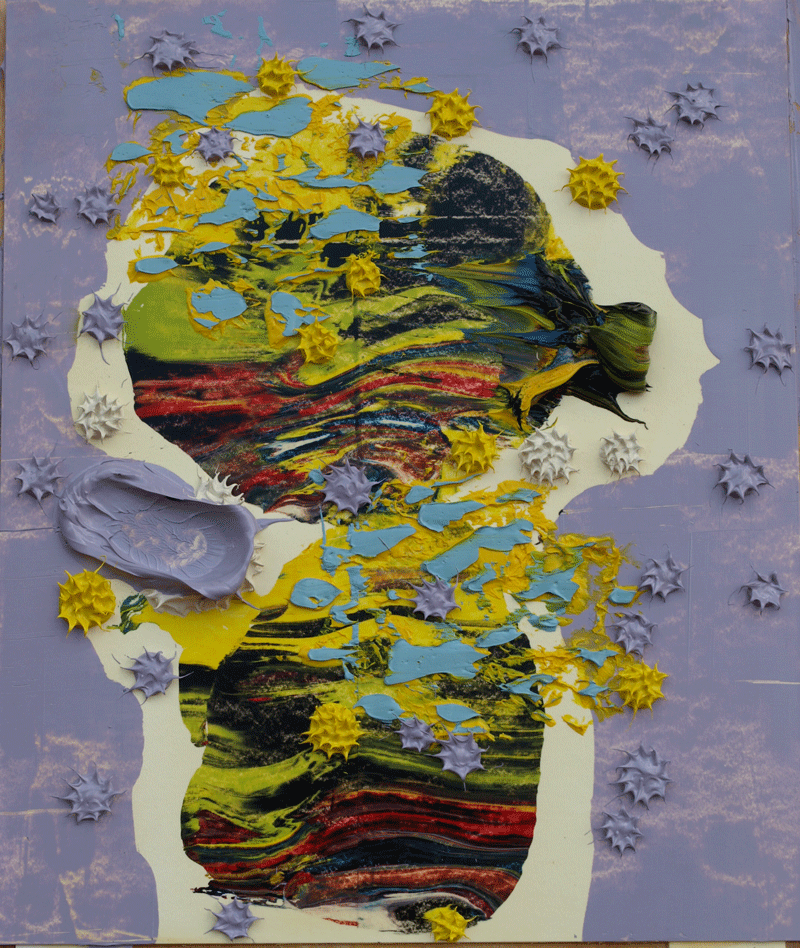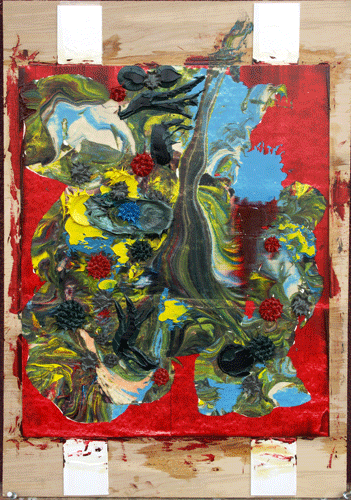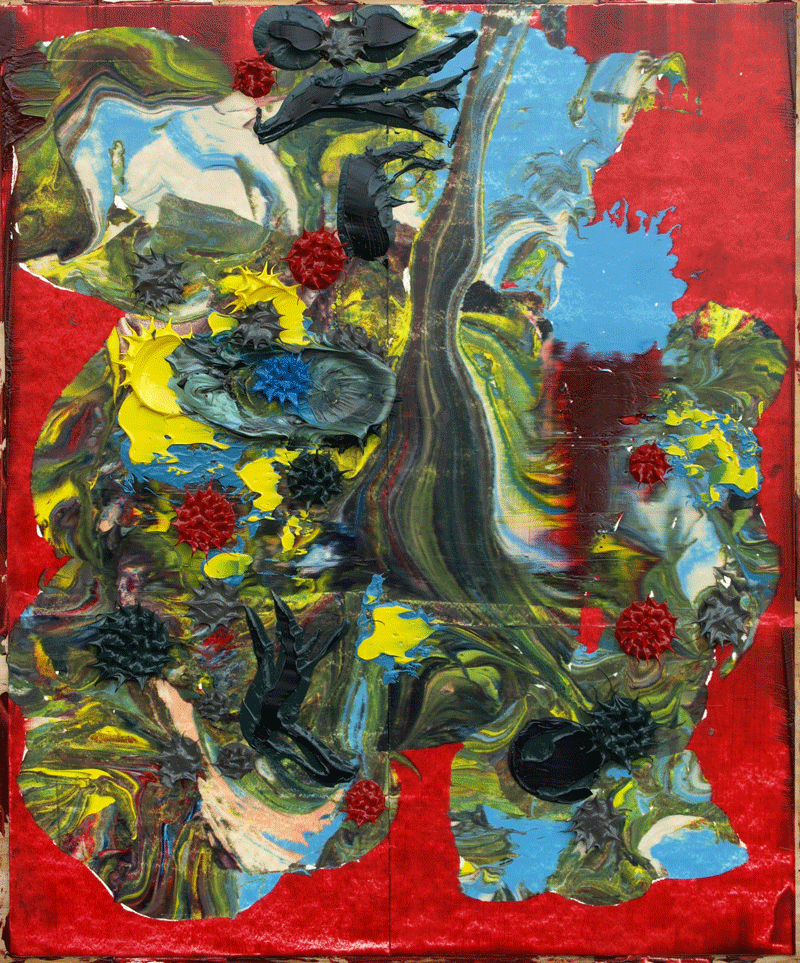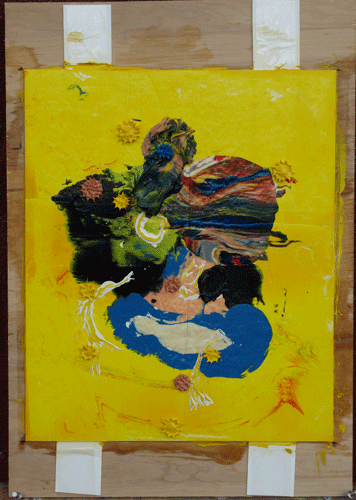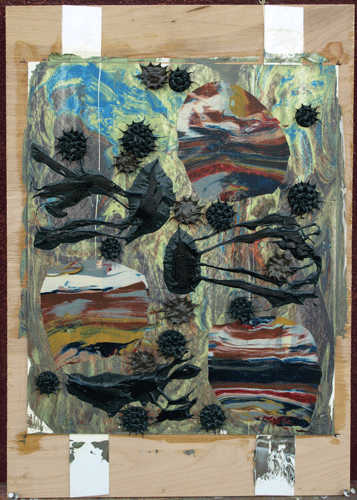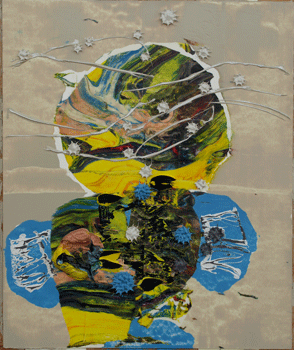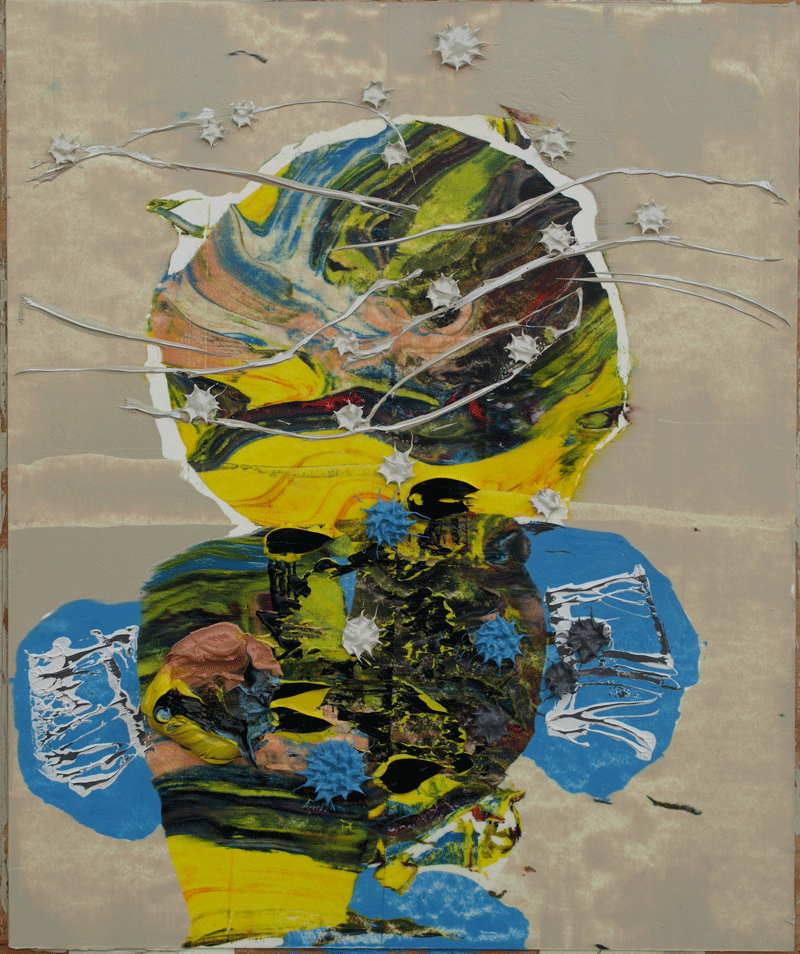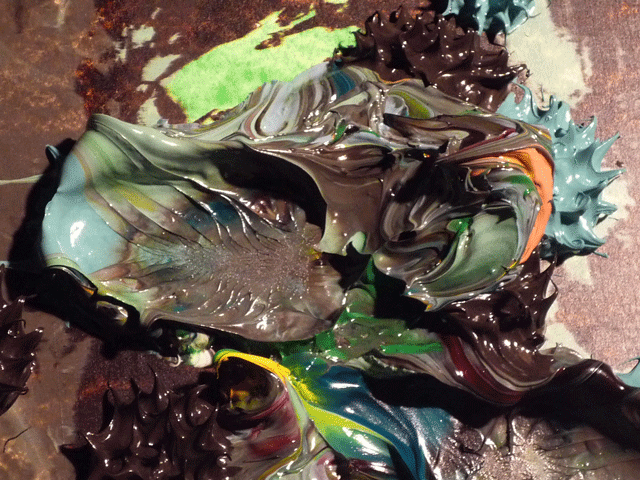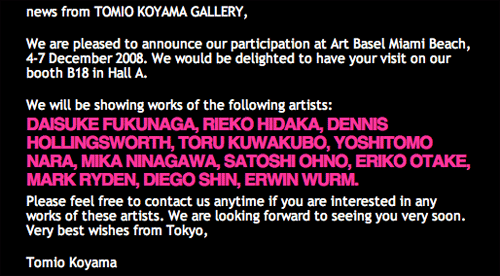December 30, 2008
December 28, 2008
ChinaTown Pan
Here is a capricho, a two minute survey of city life outside my door.
Nice big smile...

-- Post From My iPhone
Tourists flow constantly through ChinaTown, along with various photographers using CT as a provocative backdrop. This photographer asked me if it was alright if they could use my scooter as a prop. I said that I would be honored.
A couple more shots with my Lumix:
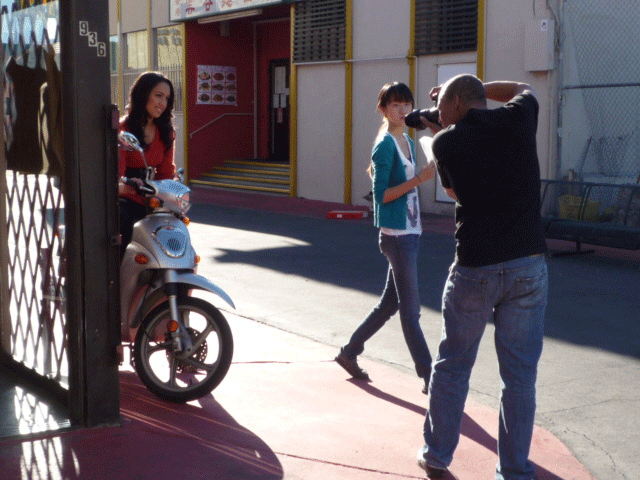
All the while he kept saying: "A nice big smile..."
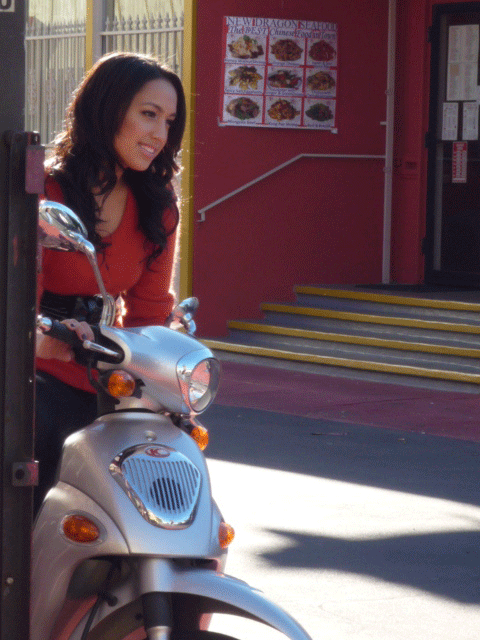
(By the way, this post sure illustrates the limitations of the iPhone camera, doesn't it?)
December 27, 2008
December 24, 2008
WOPS
The next eight entries are works on paper completed in the past couple of weeks plus.
December 23, 2008
Constellation
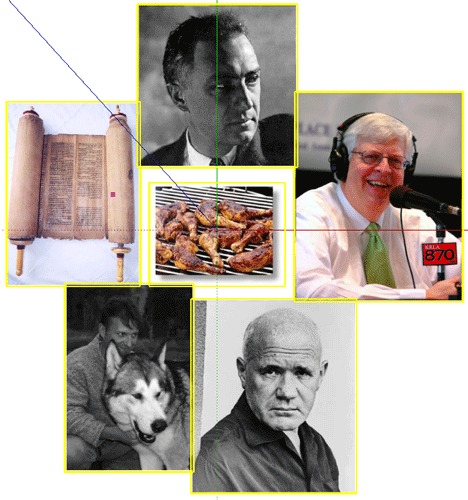
Here are a few worlds that I have been tracing together recently:
1. Late Sunday evening, I fired up the bar-b-que pit in the backyard and cooked a chicken slowly, spontaneously inviting Andrew and neighbor Paul and his new tenant, Polly. We sat round the fire as the night grew warm before the jet stream brought an arctic storm into Southern California, tequila shots and beer in moderate quantities. The conversation turned to poetry as Paul and Polly both ply the art, and I was delighted as the ever literate Andrew spurred the conversation with extended quotes from William Carlos Williams and Paul wily commented on Jean Genet. We picked flesh off the bird on the grill, warmed against the night's chill.
They talked about what makes poetry good or bad, and I caught another glimpse of the idea (and now I will try to convey my impression of it, I will fail of course) of thwarted signification and the role of the arbitrary in helping to sharpen the apprehension of subject (OK, I failed, let's try again...), the need to break the egg and the violence implied therein (close, but no cigar), of the role of misbehavior in the history of art (nope, still didn't get there). The term MacGuffin flashed in my head as they talked, Hitchcock's name for a plot device that sacrifices it's identity to serve the movement of the story, a receptacle for the imagination that must always remain a placeholder. I thought of surrealist strategy, "As beautiful as the fortuitous meeting of a sewing machine and an umbrella on an operating table". Later, I found out more about the source of this quotation, Comte de Lautr?amont, who wrote about evil as a means of making vivid, the good. Two snips from Wikipedia:I have written of evil as Mickiewickz, Byron, Milton, Southey, A. de Musset, Baudelaire and others have all done. Naturally I drew register a little exaggerated, in order to create something new in the sense of a sublime literature that sings of despair only in order to oppress the reader, and make him desire the good as the remedy. Thus it is always, after all, the good which is the subject, only the method is more philosophical and less naive than that of the old school. (...) Is that the evil? No, certainly not.and...
?letter from October 23, 1869.
The critic Alex De Jonge writes, "Lautreamont forces his readers to stop taking their world for granted. He shatters the complacent acceptance of the reality proposed by their cultural traditions and make them see that reality for what it is: an unreal nightmare all the more hair-raising because the sleeper believes he is awake."Right about that time arose the story of the custom and code of behavior in some truckstop bathroom glory holes, where certain participants place a baguette in the urinal as a signal that the rest stop was a sexual playground. Moreover, certain practitioners sometimes pinch off a corner of the bread and place it in their mouth as acidic ironic commentary on their relation to the Catholic church. I resolved to delve further into Genet. The next day, Andrew lent me his copy of Sartre's Saint Genet. Here's a tiny slice from page 2:
"His works are filled with meditations on death. The peculiarity of these spiritual exercises is that they almost never concern his future death, his being-to-die, but rather his being dead, his death as past event. this original crisis also appears to him as a metamorphosis. The well behaved child is suddenly transformed into a hoodlum, as Gregor Samsa was changed into a bug. Genet's attitude to towards this metamorphosis is ambivalent: he both loathes it and yearns for it.
Paul ended the evening's conversation with the idea that art should astonish and amaze. I held on to this, thinking about Andrew Bernardini's words at the end of the blogpost Kippenberger: at MOCA and Beyond: "...the true spirit of art: ambiguity and astonishment."
2. Dennis Prager has been holding a class on the Torah line-by-line ever since the LA riots in the early 90's. Stephanie and I attended this fall's session: Leviticus, the book of laws. I don't have access to my notes and I don't trust myself to recount the sessions with him at Brentwood's University of Judaism but here is my homemade bullet-point-rendition of Judaic apologetics:
-No where else in world civilization does exist the narrative of freedom as a central concept except in ancient Greece and Judaism.
-In Judaism, the Torah is a house of memes and the inhabitant of this house is the sanction of freedom to mankind from G-d. This singular act removes the malicious redefinition of the concept of freedom from the meddlesome hands of man, an ultimate salvation from despotism.
-Jews are the chosen people in terms of responsibility, duty, a designated task, guardianship. They must maintain the house of memes that is the Torah much like the ritual rebuilding of the Ise Shrine. Others should not envy the chore. Gratitude is a better response because the Jews live with a little less freedom that the rest of humankind, a literal and literary warrior class in biblical terms.
-G-d's charge is for us to make distinctions in the world; to pull taut a string of existence between G-d and nature; and to incline oneself towards G-d, hanging upon the line as we do. (The world has a grain to it.) The question of which set of distinctions that one makes is less important than the act of making distinctions, thus the eventual equanimity within the Judeo-Christian world and beyond.
(End bullet points.)
But then, here we are. The artists. Art progresses not only by the Oedipal turn against the constriction of previous generations... but especially by means of blurring distinctions, doesn't it? And the question hovers over us, how can we proceed when art history has had such a thorough legacy of distinction blurring? How do you question authority when the a universe of means of questioning authority has been deployed as much as it has been already, when the questioners matured into the authorities? What can we make of this in light of the points made above (re: Genet et al.)?
Mr. Prager wants to posit the purpose of art as function of elevating G-d, to incline ourselves towards him along the taut string of existence... but if art had a hard purpose such as that, what would distinguish it from other programmatic ideologies such as Marxism, where art's purpose is reduced to advancing the revolution of the proletariat? In both cases, art is mere illustration. Art's function seems instead to be concerned with maintaining the plasticity of paradigm, closer to breaking the egg as I like to say. Life is easily taken for granted, the function of art is to break that mindset. And therefore what is freedom but a world outside of the ruts and chains of bondage? Could we not say that art and freedom are interrelated? Identical perhaps? What does it mean that it is G-d himself who licenses to us this condition of freedom?
One tentative answer: I once tendered with the blogpost Personal, Difficult Things. I saw the string as a bungie chord. Elasticity, salvation and plunging into the depths of experience... another view of art?
3. From John Gray's review of Mark Rowlands' THE NATURE OF THE BEAST The Philosopher and the Wolf: Lessons from the Wild on Love, Death and Happiness, an article in Literary Review online:The bond that Rowlands formed with Brenin was based on the fact that the wolf had emotions in common with the philosopher, such as courage, affection and delight in play. At the same time, Rowlands seems clearly to have been drawn to the wolf because of its profound differences from humans. In evolutionary terms humans belong in the ape family, and if apes are intellectually superior to other animals it is because of their highly developed social intelligence. Some of the most valuable features of human life - science and the arts, for example - are only possible because of this intelligence. But it is also this type of intelligence that enables apes - some kinds of ape, at any rate - to engage in forms of behaviour that, when more fully developed, embody types of malignancy that are pre-eminently human. As Rowlands puts it: 'When we talk about the superior intelligence of apes, we should bear in mind the terms of this comparison: apes are more intelligent than wolves because, ultimately, they are better schemers and deceivers than wolves.' The ability to scheme and deceive requires a capacity to enter the minds of others, which other animals seem not to possess in anything like the same degree. But the human capacity for empathy brings something new into the world - a kind of malice aforethought, a delight in the pain of others that aims to reduce them to the condition of powerless victims. If the philosopher loved the wolf, it was because while it could kill without emotion it lacked this distinctively human trait. Among other things The Philosopher and the Wolf is a series of unsentimental reflections on human evil. Rowlands does not think of evil in simple terms, as mere Schadenfreude - it is far more complicated than that. But neither does he share the rationalist delusion that evil is a kind of error, which can be removed from human life by better knowledge and improved understanding. On the contrary, unfashionably but to my mind rightly, Rowlands accepts that evil is part of human nature, which can be moderated but never eradicated. Mark Rowlands tells us he has long pondered the claim, often advanced as an objection to his life with Brenin, that wolves have no place in civilised society, and has finally concluded that it's true. The reason is not that Brenin was too dangerous to be allowed in civilised company. Rather, it is that 'he was nowhere near dangerous, and nowhere near unpleasant, enough. Civilisation, I think, is possible only for deeply unpleasant animals.' I would put the point rather differently. Civilisation is a way of coping with what that supremely great twentieth-century poet Wallace Stevens called 'the unalterable necessity of being this unalterable animal'. The dark side of the human animal is not wolf-like; it is ape-like, and at its worst peculiarly human. In other words, civilisation is a defence erected by humanity not against bestiality, but against itself.
(Emphasis Mine.)
December 22, 2008
Going to Snow Country

A ride on the jet stream for a couple of snow angels.
-- Post From My iPhone
Saturday Night
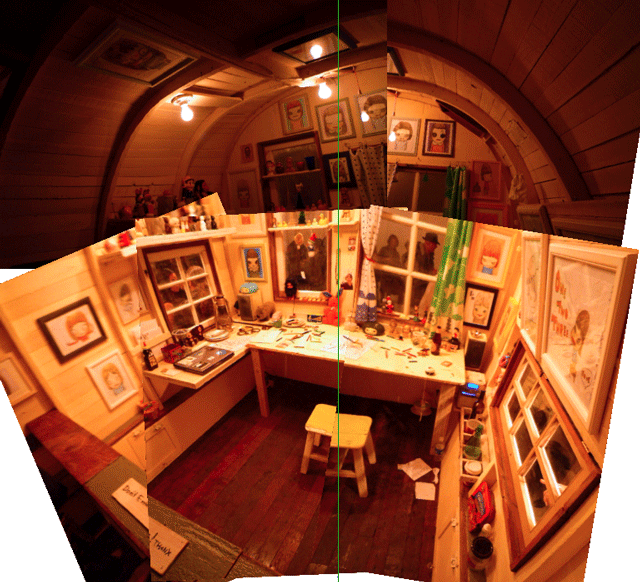
Yoshitomo Nana camped out at Blum & Poe.
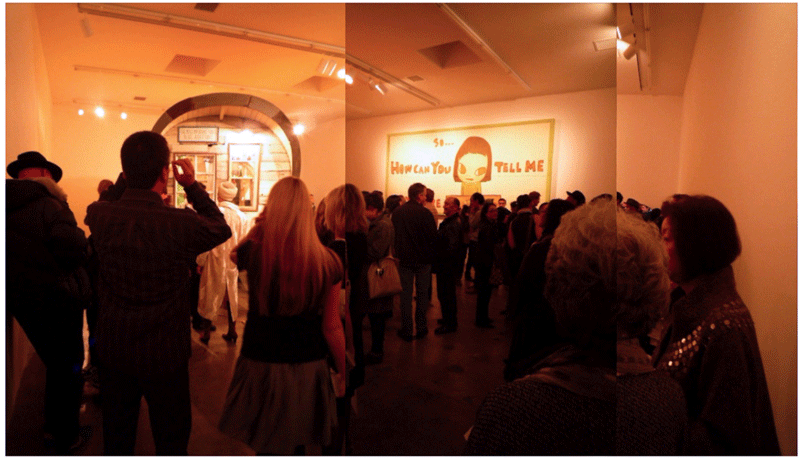
Moon doors, crowds like bees around a performance, cartoon actors and make believe worlds come true. Teams of Santa's helpers offstage who help reify the shared private world. Children's books all grown up.
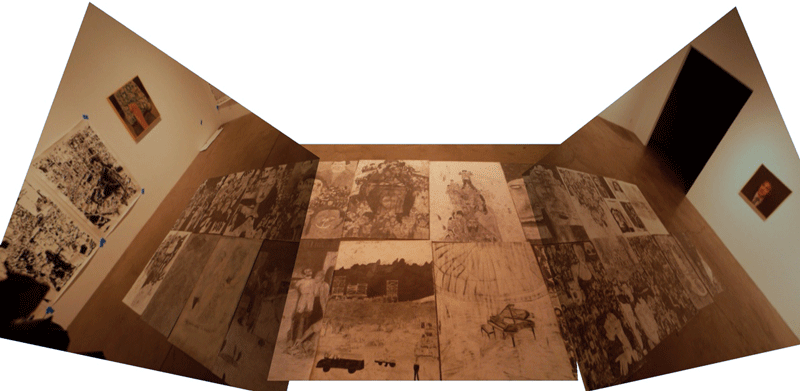
Later, we stopped by Angstrom Gallery to see the recent work of Matt Chambers.
He's getting to be one with the graphite, Ticonderoga pencils and HB lead all up his yin-yang.
Test

Test
-- Post From My iPhone
Excellent. A new era dawns.
Merry xmas, Happy Chanukah everyone!
December 17, 2008
December 15, 2008
Morgan Fisher
This is a one minute, fifteen second tour of Morgan Fisher's closing show at China Art Objects. I talked to him about his work, he described colors in space in an architectural relation to one another. He didn't use the term "architecture", but I was ready to. I could see how he thought in terms of inhabited space, human experience in bodily terms, vectored with sight lines and movement, the keynote of procession which is a prime indicator of architecture. I figured that a short mpg of the show was the best way to represent it here, roughly a minute on each side of the wall that divides the two galleries of China Art Objects. I thought immediately of my favorite books, Rudolf Arnheim's Art and Visual Perception and E. H. Gombrich's Art and Illusion. He took this reference as a nice surprise. I could imagine his mental universe as one that operates comfortably within those worlds. Of course, I must admit that this is probably more of a projection than an an accurate description of his project. He is quite a civil person, and he might have been too polite to say otherwise in our brief encounter. I look forward to more.
December 14, 2008
This Too Shall Pass
When times are rotten, life isn't as bad as it seems.
When times are fantastic, life isn't as good as it seems.
December 12, 2008
Ana Serratosa
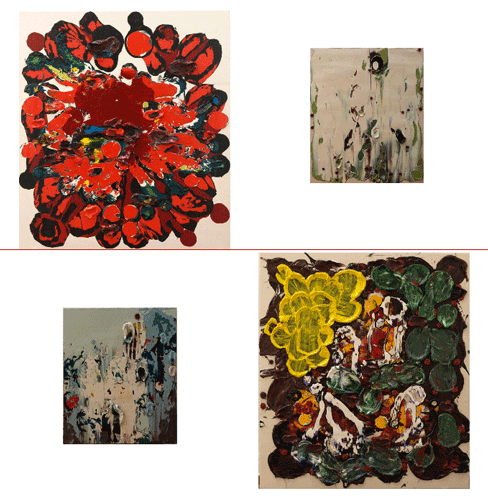
Via my gallery in Barcelona, four pieces from this summer's work opened at a private gallery in Valencia, Spain this week. Ana asked me for some kind of personal introduction to my work for her collectors there, so I proposed a letter from me to be read by her at the opening. The brilliant and beautiful Gemma Farreras (who is now working for Miguel Marcos, my gallery in Barcelona) worked hard last weekend to deliver an excellent translation in Spanish. I wish my Spanish was this good:
Me gustar?a empezar expresando mi m?s sincera gratitud a Ana Serratosa por brindarme la oportunidad de exponer mis obras en Valencia y, por extensi?n, tambi?n a todos ustedes por acudir a verlas. Estoy especialmente agradecido por exponer mis obras en Espa?a, especialmente porque nac? en Madrid pero dej? la ciudad cuando s?lo contaba con tres a?os de edad. Mucho m?s tarde, cuando era un adolescente, pas? de nuevo por Europa con mi familia de camino a Australia, y tuve la gran oportunidad de pasar una semana en el Prado. Por aqu?l entonces ya dibujaba todo el tiempo, el arte ha estado presente en mi vida desde que tengo uso de raz?n. La obra de Goya era particularmente emocionante, especialmente porque pude ver sus Caprichos, que se expon?an en aquel momento. Recuerdo quedarme de pie, observando su famoso Saturno devorando a sus hijos, sintiendo c?mo mi mente se llenaba de pigmentos, mi campo visual completamente dominado por la visi?n terrible y a la vez demasiado humana de Goya. Fue en ese preciso instante cuando supe que ten?a que convertirme en artista, que ten?a que ser pintor. Me ha costado la mitad de mi vida volver a Espa?a, soy un hijo pr?digo.Lo que est?n viendo ustedes hoy es una selecci?n de obras pintadas durante este pasado verano. Creo que el tema supremo de la Historia del Arte es, precisamente, el ?mon?logo interior? de un artista durante su trabajo en el estudio. El di?logo art?stico contempor?neo discute lo que puede representar el trabajo de un artista, la necesidad de un estudio en s? misma, la existencia del propio artista o de la consciencia, e incluso si la Historia ha terminado. A pesar de todo eso, yo creo que el Arte es la historia de la curiosidad y el disfrute humanos, especialmente si la historia tiende a contar los malos comportamientos. Navego por esta corriente de pensamientos c?mo un velero navega con el viento: alterno el tim?n entre babor y estribor, seg?n el momento. En los cuadros Moving with the Mind a Wander y Tide and Eddies and Currents and Undertow, empec? con un dibujo que se borr? hasta cierto punto. En ?Mago, Mago, Ven Aqu?!, dej? que el dibujo formara una composici?n radial, quiz? una encarnaci?n del asombro. En Damocles, volv? las tablas del rev?s y busqu? otra forma de ?dibujar?, esta vez con gruesas marcas de pintura, c?mo si fuera una escena feliz dibujada con el estilo de un monstruo.
Mientras que generalmente acepto el apodo ?abstracto? referente a mi trabajo, tambi?n afirmo que la abstracci?n y la representaci?n son como el Polo Norte y el Polo Sur. He acabado comprendiendo que la Historia del Arte ha colocado m?s que suficientes banderas en cada uno de estos polos, y yo no necesito a?adir otra. En lugar de eso, el conocimiento de esos polos puede darnos una gu?a para navegar el mundo de la pintura de forma mucho m?s amplia. As?, la pureza de la abstracci?n o de la representaci?n es menos importante para m? que la forma en que una se forma en la otra, c?mo la realidad y la imaginaci?n se sirven mutuamente, c?mo una influye a la otra. adem?s, la pureza es menos importante para m? que la mezcla, pero a la vez persigo el ?arco tensado de Her?clito? para encontrar la armon?a cr?tica y necesaria en la mezcla de los opuestos.
Llamo a estas pinturas ?H?medo sobre h?medo?, lo que se conoce c?mo alla prima, y consiste en pintar en el tiempo de secado de la propia pintura. Mientras estaba en bachillerato, me situ? en una postura cr?tica a las teor?as art?sticas predominantes, que tend?an a favorecer un tipo de arte demasiado dise?ado, demasiado seguro de sus significado ?es decir, obras de arte que se interpretaban mucho antes de ser creadas. Quer?a pintar de un modo que hiciera posible la equivocaci?n, y la limitaci?n del tiempo que supone la t?cnica alla prima era c?mo jugar al ajedrez con un cron?metro. Por supuesto, con alla prima, todos los errores se enmiendan sobre la marcha, una iron?a que encuentro deliciosa.
La estrategia de ?H?medo sobre h?medo? se estableci? r?pidamente: pintar r?pidamente en el m?ximo de formas posibles, mantener cada toque c?mo si creara un lenguaje propio. A partir de ah?, una manada de formas f?sicas se manifestaron: bolas espinosas que recuerdan erizos de mar (a las que bautiz? ?Monads?); elementos fractales impresos transmitidos en el lienzo por papeles, cosa que recuerda las decalcoman?as de Max Ernst; un m?todo con el que se utilizan herramientas que podr?as encontrar en una ferreter?a para alisar la superficie, sacando pintura con fragmentos de cart?n; ?daubers? hechos a mano con tela tejida para crear flores? era c?mo si hubiese encontrado un men? secreto en un programa inform?tico para pintar. Pintaba de forma afirmativa, aceptando las cualidades formales de la pintura de la misma forma que aceptaba su color y su tonalidad. Me divert?a pintando, igual que me divierto ahora.
Mis padres se conocieron en Madrid a mediados de los 50. Mi padre, de Missouri y Texas, era un hombre de carrera militar, enrolado en las Fuerzas Armadas del ej?rcito de los Estados Unidos y destinado a Torrej?n de Ardoz. Mi abuelo materno, filipino, hab?a enviado a sus hijos de Manila a Madrid para acabar sus estudios. Mi familia viaj? por todo el mundo, y mi hermano y yo vivimos en muchos lugares distintos: Virginia, Filipinas, Nuevo M?xico, Panam?, Missouri, Las Vegas, Florida, Australia. M?s tarde, cuando acab? el instituto me enrol? en la Marina por muchas razones: honorar a mi padre, pagar la universidad, ver m?s mundo, tener tiempo de planear mi educaci?n c?mo artista. Entonces decid? planear un ostentoso proyecto para mi educaci?n: primero arquitectura, y luego pintura y escultura. Tan pronto como me entregaron la licencia de arquitecto, empec? un posgrado en arte. Les estoy explicando esta historia para transmitirles un sentimiento de estar entre dos mundos, de mestizaje, de hibridaci?n y heterogeneidad, de existencia en un mundo que no est? exactamente aqu? ni all?.
Espero que esta peque?a rese?a biogr?fica tambi?n exprese el origen de mi predisposici?n a la diversificaci?n intelectual: dejar que las ideas crezcan desde abajo, no intentar crear obras de arte que insista en su propia inteligencia, pero intentar ser lo m?s inteligente posible. Y, con suerte y esfuerzo, dejar que la riqueza de experiencias transpire por mis poros. ?sta es la raz?n de la irrupci?n de internet, mi blog, mi diario de estudio on-line. Me he acostumbrado a utilizar mi blog c?mo instrumento para registrar mi curiosidad y c?mo m?todo para derivar los t?tulos de mis obras ?y as? confirmar su contenido. Les invito a examinarlo, los t?tulos de todas mis obras est?n all? representados.
Me gustar?a agradecer a mi galer?a en Barcelona, Miguel Marcos, qu? es mi representante en Espa?a. Me siento afortunado de tener a la vez una sincera amistad y una excelente relaci?n personal con ?l, a un muy alto nivel. He sido muy afortunado de trabajar con galer?as en todo el mundo, ya que de siempre ha sido mi sue?o mostrar mi trabajo de forma internacional. En particular, mi mujer y yo siempre hemos seguido el consejo de mi abuelo, ?s? c?mo un ?rbol y incl?nate en la direcci?n en que quieres caer?, y por eso siempre hemos querido vivir a la vez en Estados Unidos y en Europa. As?, poco a poco, hemos ido logrando este sue?o, viviendo tanto en el sur de California c?mo en la Costa Brava. Esta presentaci?n en la fant?stica ciudad de Valencia es otra realizaci?n de estos sue?os, y no puedo evitar reiterar mi gratitud a Ana Serratosa por su gentileza, entusiasmo y generosidad present?ndoles mis obras.
Atentamente,
Dennis Hollingsworth
Here it is in English:
I would like to begin with a heartfelt expression of gratitude to Ana Seratossa for the opportunity to exhibit my paintings in Valencia, and by extension, my thanks to you all for coming to view my recent work. I am particularly thankful for the opportunity to show my paintings in Spain, especially since I was born in Madrid but left with my family when I was three years of age. Later, when I was a teenager, I was transiting Europe with my family while en route to Australia and I had the opportunity to spend a week at the Prado. I was already drawing a great deal at that time, art has been vivid in my life since my earliest memory. Goya's work was particularly electrifying, especially since I was able to view his Caprichos, also on exhibit at that time. I remember standing in front of his famous painting, "Saturn, Devouring his Children", feeling my mind flood with pigment, my entire visual field dominated by Goya's terrible yet all-too-human vision. It was then I knew that I had to be an artist, that I had to become a painter. It has taken me half a lifetime to return to Spain, a prodigal son.
What you are viewing today are a selection of works on canvas and wood panel, painted during the summer of this year. I believe that it is the stream of consciousness of an artist at work in the studio that is the supreme subject for art history. Even though our contemporary dialog contests what an artist's work might comprise, if a studio is necessary at all, if the designation of "artist" or even consciousness exists, if history itself has ended; I maintain that art is the story of human curiosity and delight, especially if the story tends to chronicle bad behavior and the Oedipal turn. I navigate the stream as a sail boat tacks into the wind: I wheel to port for a time and wheel to starboard for another. In the paintings "Moving with the Mind a Wander" and "Tide and Eddies and Currents and Undertow", I began with a drawing that was erased to some degree. In "?Mago,Mago, Ven Aqui!", I let the drawing delineate a radial composition, an embodiment perhaps of amazement. In "Damocles", I upended the tables and sought another way to "draw", this time with fat marks of paint, as if it were a happy scene drawn with the stylus of a monster.
While I generally accept the moniker of abstraction in the description of my work, I more broadly assert that abstraction and representation are like the geographic poles, north and south. I have come to believe that the history of art has placed more than enough proprietary flags on each of these poles and I need not add another. Instead, knowledge of these poles can deliver a kind of compass that can be used to navigate the world of painting at large. Therefore, the purity of abstraction or representation is less important to me than how one morphs into the other, how reality and the imagination can serve one another, how one is implied by the other. Indeed, purity for me is less important than entanglement, but at the same time, I seek the strung bow of Heraclitus to find a necessary and critical tension in a mixture between antipodes.
I call these paintings "Wet into Wet", otherwise known as alla prima, which is the act of painting within the drying time of the paint. While I was in graduate school, I became critical of the influence of the prevailing art theories which tended to favor art making that was too designed, too sure of it's meaning -that is, art objects that were over-determined long before they were made. I wanted paint in a way that was possible to fail, and the time limitation of alla prima was like playing chess with a tournament clock. Of course, with alla prima, all missteps are eliminated along the way, an irony that I found delicious.
The strategy of Wet into Wet fell into place quickly: to flash paint onto the surface in as many different ways possible, to maintain each touch as in a language of mark making. From this, a menagerie of physical forms became manifest: spiny balls that resemble sea urchins (I called them "Monads"); printed fractal elements that were delivered with peeled paper that resembles Max Ernst's decalcomania; a method of flattening the surface with tools that one could find in a hardware store, scooping paint off with shards of cardboard; handmade daubers made of knit fabric that formed the flower petal-like elements... It was as if I found a hidden pull-down menu in painting's computer program. I was painting in the affirmative, accepting the formal qualities of paint alongside that of color and tonality. I was then, as now, having fun.
My father and mother met in Madrid in the mid '50s. My father, who was from Missouri and Texas, was a career military man, enlisted in the U.S. Airforce, stationed at Torrejon. My maternal Filipino grandfather had sent his children from Manila to Madrid to finish their education. My immediate family had travelled the world and my brother and I grew up in many places: Virginia, Philippines, New Mexico, Panama, Missouri, Las Vegas, Florida, Australia. Afterwards, I joined the US Navy after high school for several reasons: to honor my father, to pay for college, to see more of the world, to have the time to plan my education as an artist. It was then I decided to build a grandiose project of my education: first architecture, then painting and sculpture. As soon as I received a license to practice architecture, I enrolled in a graduate school in art. I am relating this history to you in order to convey a feeling of being between worlds, of the mongrel, of hybridity and heterogeneity, of existing in a world which is neither here nor there. I hope this short biographical sketch can also convey the source my bias towards intellectual content: to let ideas brew up from below, to not try to make art work that insists on it's intelligence but to try to be as intelligent as possible. And with luck and effort, to instead allow a richness of experience seep through my pores. This is the reason why I am fond of the recent advent of internet web-logging, the blog, my online studio diary. I have come to use the blog as an instrument for registering my curiosity and as a method of deriving my titles -and therefore confirming the content- of my work. I invite you to peruse it. All of the title of my paintings are hyperlinked for this purpose.
I would like to thank my gallery in Barcelona, Miguel Marcos, who is my primary representative in Spain. I feel blessed to have simultaneously a friendship and an excellent working relationship at such a high level. I have been fortunate to be able to work with a team of galleries worldwide, it has been my longstanding dream to show my paintings internationally. In particular, my wife and I have heeded my grandfather's advice to "...be like a tree and lean in the direction you would want to fall" and therefore we have always wanted to live both in the USA and Europe. And little by little, we have been making this dream come true by living both in the Costa Brava and Southern California. This particular show in your famed city of Valencia is another fruition of these dreams, and I cannot tire of repeating the expression of my gratitude to Ana Seratossa for her grace, enthusiasm and generosity in presenting my paintings to you.
Sincerely,
Dennis Hollingsworth
December 11, 2008
December 8, 2008
Saturday Night
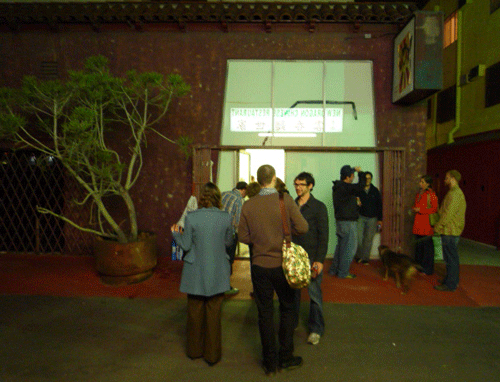
My next door neighbor, Evan Lintermans offered his studio to friends to form an installation comprised of and partly inspired by... his stuff. Like mushrooms after a rainfall. It was a one night stand, in and out like a movie shoot. I generally like the idea of special worlds found in the mundane, epiphanies tucked away in the commonplace. Horton Hears a Who. Hope, abounding beneath one's nose. Redemption? (It's time to reel the idea back in a bit.)
Years ago, I nursed an notion of inviting a group of artists to the university campus where I taught architecture design as an adjunct professor, to orchestrate a number of installations at various sites on campus. I found resonance in Evan's gig. Elonda Billera, James Boulton and Nate Page took cues from Evan's stuff, squeezing a palette of art materials from its' context like a juicer. Said materials were deployed with archangel Robert Smithson hovering aloft with little asides like Site/Non=Site with water bottles switching out the piles of dirt, half buried woodsheds and entropic flows.
Or maybe I was projecting?
I mashed a video together. (Emphasis on the word "mash".)
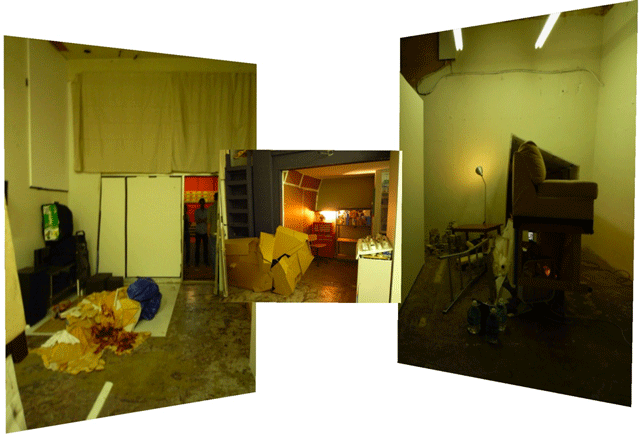
It was off-grid, here and gone, unofficial, a show for friends, art for art's sake in a real way. If I didn't make this blogpost about it, it would have evaporated into the thinning air of art history, whatever that is, nowadays.
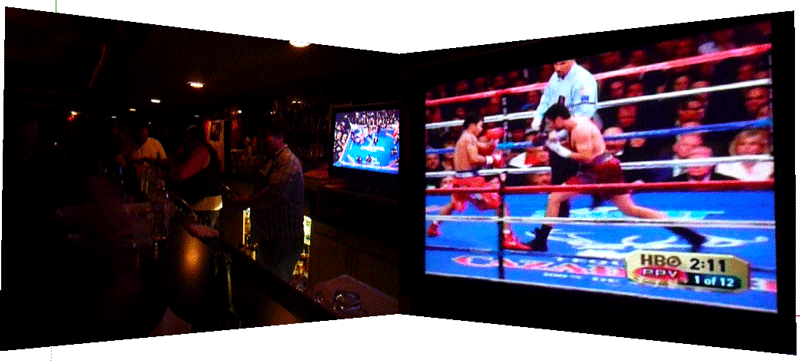
Meanwhile, Pacquino kept shooting his fist between De LA Hoya's gloves, reducing his left cheek into ground meat. Brutal. Hop Louie Bar is the best fight bar in LA as far as I know. Folks packed the premises, sharp commentary and groans and whoops. By the end of the night, a hometown hero's loss blanketed the bar with a morose fog. Patrons dissipated and were soon replaced by post-opening revelers.
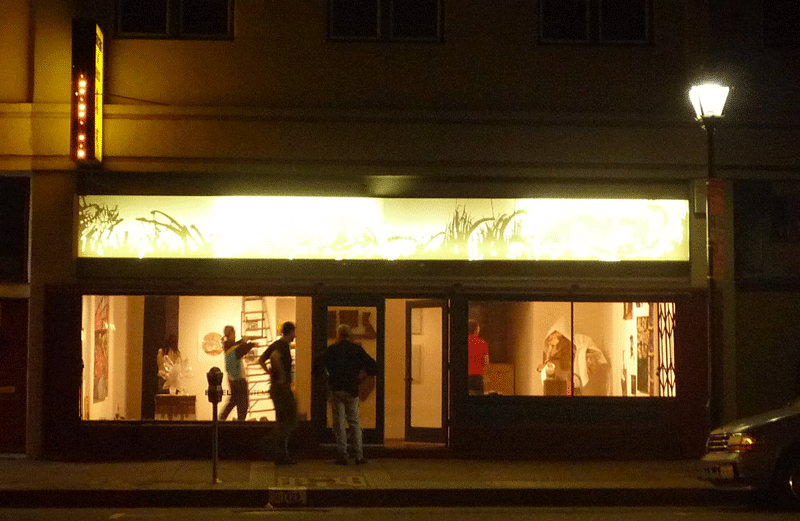
This is a shot of Bonnelli Gallery's facade the night before as Skip Arnold (to the right,black jacket, arms akimbo) coordinated the install. Globetrotter, Skip is a grey wolf performance artist, often using his body as his art material. Keeping the good times rolling, he invoked the spirit of Dean Martin in a sprawling group show that probably needed a kunsthalle for elbow room.
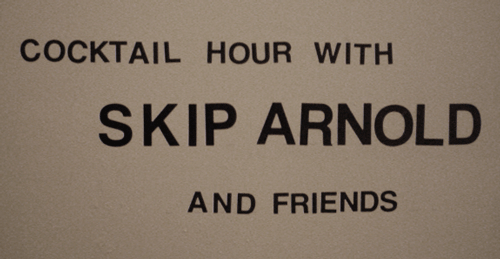
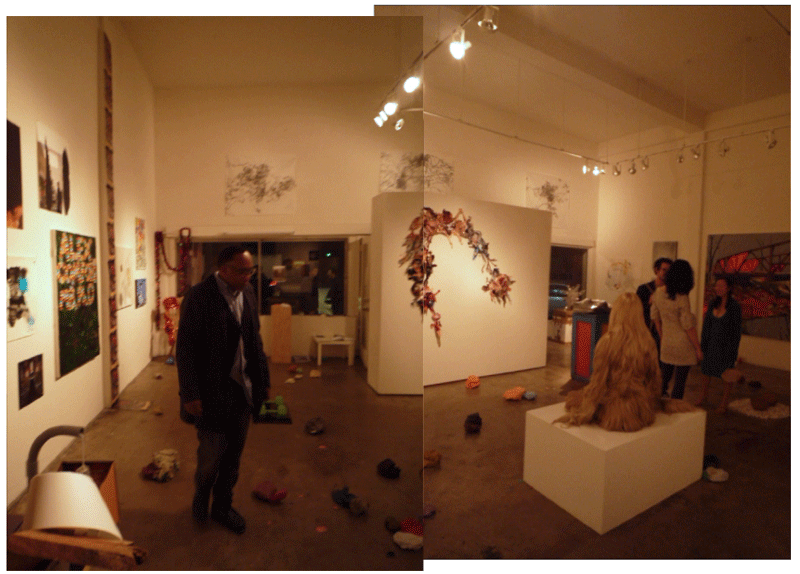
Around that time, Henry showed up. Just when you thought the party was over, it was really getting started.
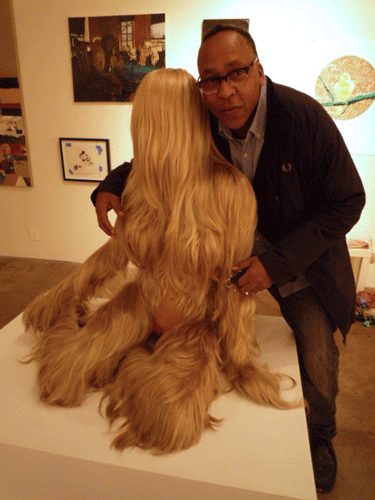
The show was packed to the gils, it will take another visit to sort things out. At least Karen Lofgren got to place her "Mermaid" as as centerpiece. I called it a Chicka Yeti.
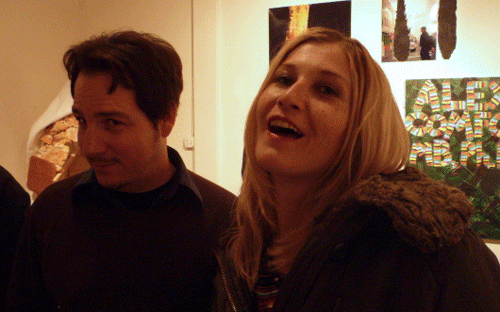
*
*
*
(...regarding the prolonged "BLOGPOST IN PROGRESS": I have been switching laptops recently, lots of wrinkles to iron out.)
December 1, 2008
Mark M?ller, Room 3
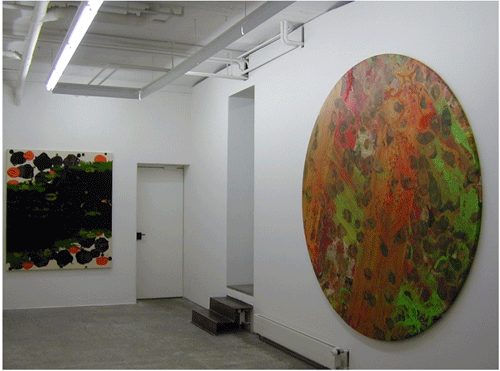
Here's a shot of Room 3: Accrochage at my gallery in Z?rich, Mark M?ller Galerie. I'm there with Urs Frei, Stefan Gritsch, Katharina Grosse and Judy Millar. That's Katharina Grosse's disk to the right of the shot, Untitled, (2006). I titled my painting in the show: Love freedom, Hate Slavery (2006).

